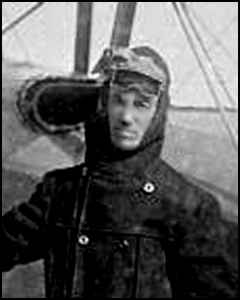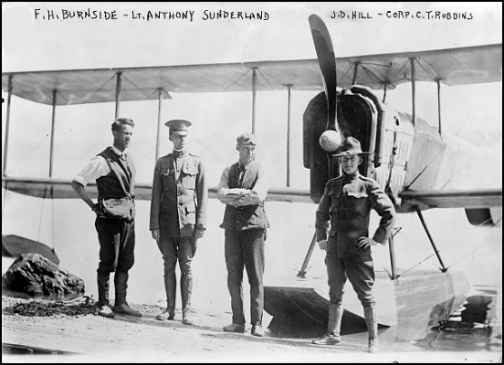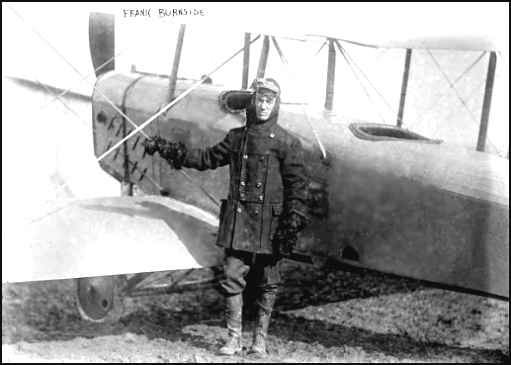
1888-1935 AKA Frank Herbert Burnside |
 |
 |
|
|
Frank H. Burnside,
Anthony Sunderland, National Guard Student, James D. Hill, Instructor, Corp. Chas. Robbins, Ark. National Guard Student At the Thomas School of Flying. from AERIAL AGE WEEKLY, July 24, 1916 p. 560 |
|
1928 FRANK HERBERT BURNSIDE Aeronautical Activities and War Service: Learned to fly Dec. 1911; exhibition flying instruction and test pilot, Thomas Bros., 1912 to 1915; 1915 Pilot for Curtiss Co.; 1915 to 1923 Test Pilot and Instructor for Thomas-Morse Aircraft Work; 1923 to Sept. 1926, inspector; test and experimental work U. S. Air Mail, Chicago; Sept. 1926 to Sept. 1927, Pilot U. S. Air Mail Cleveland and Chicago run; Sept. 1927 Pilot for National Air Transport Corp., Cleveland and Chicago run. Flying Rating: F. A. I. No. 212. Present Occupation: Aviator, Air Mail. Address: 15123 Arden Ave, Lakewood, Ohio |
| Monday, August 30, 1999 |
| Local history column by Mark Simonson | thedailystar.com |
|
The first flight around Oneonta was in 1910. A `barnstormer` became quite an attraction at the 1910 Oneonta Fair, promising to provide thrills to the fairgoers. Unfortunately, the pilot took off from a farm pasture on Oneonta's south side, but crashed shortly after takeoff and never got to the fairgrounds. A year later though, another pilot, Walter Johnson, successfully gave flying exhibitions at the fair. Oneonta boys Frank Burnside and Earl Fritts were at that demonstration, and needless to say, the flying bug bit them. By the end of 1911, the two pals had graduated from the new Thomas Brothers Flying School, in Steuben County's town of Bath. These two became one of the first in the world to become licensed to fly an aircraft. Fritts came back to the Oneonta area to `barnstorm` a bit, but soon retired from flying. Burnside continued and accumulated an impressive Thomas Morse biplane in July 1913, at 12,950 feet! Burnside stayed on as an instructor with the Thomas Brothers, and eventually moved with the company to Ithaca. But he also flew in some early `flicker` movies by the Grossman Picture Corporation. He piloted for stars such as Irene Castle, Lillian Walker, and Edith Day. In 1914, Burnside made the first flights from the U.S. to the Dominican Republic, Rio de Janeiro, and from Miami to Havana. He also became a pioneer of air mail flying. The first major airfield came to Oneonta in 1927. D.F. Keyes converted 190 acres of land on the Oneonta Plains, for such use. That's now in the area where NYSEG Corp. and the National Soccer Hall of Fame are located. It became Keyes Airport. At first there were no hangars for the airplanes. Eventually, there were three runways up to 1800 feet long, going toward the soccer fields of today, and another parallel to Country Club Road. Pilot Carlton Hinman of Cooperstown first landed his Canadian Curtiss airplane at Keyes Airport. Keyes was not the first airport around Oneonta. Another was run by Charlie Georgia, but the exact location is uncertain. In a separate but significant chapter of local aviation history, Scintilla of Sidney, now Amphenol, built magnetos for airplane engines. During World War I, a group of engineers in Switzerland developed an outstanding magneto. After the war, a Chicago promoter Laurence R. Wilder obtained the American agency and brought the magneto to the U.S. in 1921. Scintilla was located in New York City at the time. Meanwhile, Sidney had recently lost its big manufacturer, the Hatfield Automobile Company, as it just couldn't compete with Detroit. A former Hatfield official, Winfield Sherwood, volunteered without pay to search for a new industry for the village. Sherwood hit paydirt in 1924, as he invited Scintilla officials to Sidney, convincing them to bring this superb magneto manufacturing line to the Tri-Towns. They moved into the old Hatfield plant. By 1928, Scintilla had a much better factory, and was purchased a year later by Bendix Aviation Corporation. Somehow, the company survived the Great Depression, and by 1939, was filling orders for airplane magnetos for the Allies in Europe. Next time, after Labor Day, we'll put on the helmets, shoulder pads, and head out to the ol' gridiron! City Historian Mark Simonson's column appears weekly on this page. If you have feedback or ideas about the column, write to him at The Daily Star, or e-mail him at simmark@stny.rr.com Editors Note: This informative article by Mark Simonson, the Oneonta city historian and freelance writer for the Daily Star, Oneonta, is reprinted with the kind permission of the author. We are grateful for his contribution. |
 |
|
|
Frank H. Burnside Library of Congress Collection |
|
Editor's Note: This collection is housed in the New York Historical Society Collection. |
|
|
|
|
|
Frank H. Burnside, aged 47, musician, pioneer aviator, instructor, exhibitioner, air mail pilot and flight
consultant, died august 26, 1935 at his home in Bath, N.Y., after six weeks' of illness. EBs
William T. Thomas and Howard Shafer and
other old friends attended the services. Early Frank studied music, but flying attracted him and he started his aviation career as test pilot, instructor and exhibition flyer for the Thomas boys at Bath. Later he joined Curtiss as a test pilot. During the war he tested the Thomas-Morse and instructed. He flew the mail across the Alleghanies to Chicago in rebuilt "flaming coffins" and was one of the first night pilots on the transcontinental before the days of beacons and radio. From 1930-1939, when he retired to business in Bath, he was called upon by a number of aircraft companies for test and consulting work. Prior to his retirement he was test pilot for the Smith company in developing its controllable pitch propeller used by Wiley Post around the world. Frank's main work was the pioneering in new ships and new equipment. He was loved by all who knew him. courtesy of Steve Remington - CollectAir If you have any information on this Early Bird, please contact me. E-mail to Ralph Cooper Back 

|